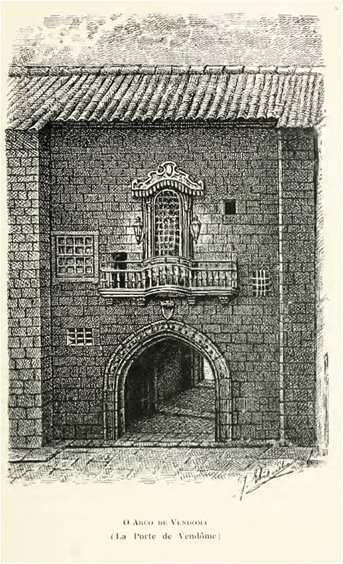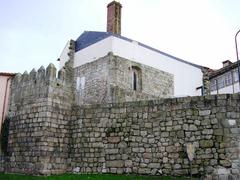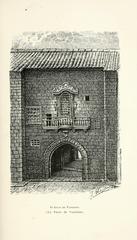
Comprehensive Guide to Visiting Muralha Velha, Porto, Portugal
Date: 25/07/2024
Introduction
Muralha Velha, also known as the Old Wall, is a historical gem nestled in the heart of Porto, Portugal. This ancient fortification has its roots in the Roman era, offering a captivating glimpse into the city’s extensive past. Initially constructed by the Romans in the 3rd century, the wall has undergone numerous transformations, particularly during the medieval period when Porto emerged as a significant economic and cultural hub (Wikipedia). Muralha Velha’s architectural significance is underscored by its amalgamation of styles from different periods, making it a living testament to the evolution of defensive structures over the centuries. The remnants of these fortifications today stand as a silent witness to the city’s resilience and historical continuity. This comprehensive guide aims to provide an in-depth exploration of Muralha Velha’s history, visitor information, and travel tips, ensuring that every visitor can fully appreciate this marvel of Porto’s heritage.
Table of Contents
- Introduction
- Roman Foundations
- Medieval Expansion
- Architectural Significance
- Preservation Efforts
- Visitor Experience
- Cultural Impact
- Educational Value
- Accessibility and Amenities
- Visitor Information
- Travel Tips
- Future Prospects
- FAQ
- Conclusion
Roman Foundations
Muralha Velha has a rich history that dates back to the Roman era. The Romans, known for their strategic urban planning and architectural prowess, established the initial fortifications in this area. These early structures were part of a broader network of defenses designed to protect the burgeoning settlements and trade routes that were vital to the Roman Empire. The remnants of these Roman walls can still be seen today, offering a glimpse into the ancient past and the sophisticated engineering techniques employed by the Romans.
Medieval Expansion
During the medieval period, the significance of Muralha Velha grew as Porto became an important economic and cultural hub. The fortifications were expanded and reinforced to protect the city from various threats, including Viking raids and internal conflicts. The medieval walls were constructed using local granite, a material that provided both strength and durability. These walls not only served a defensive purpose but also delineated the boundaries of the city, influencing its urban development.
Architectural Significance
The architectural significance of Muralha Velha lies in its ability to showcase the evolution of defensive structures over centuries. The walls incorporate elements from different periods, including Roman, medieval, and even later modifications. This amalgamation of styles provides valuable insights into the changing architectural practices and technological advancements over time. Visitors to Muralha Velha can observe the distinct construction techniques and materials used in different eras, making it a living museum of architectural history.
Preservation Efforts
In recent years, significant efforts have been made to preserve and restore Muralha Velha. These initiatives aim to protect the historical integrity of the site while making it accessible to the public. Preservation efforts include structural reinforcements, cleaning, and the installation of informative plaques that provide historical context. These measures ensure that future generations can continue to appreciate and learn from this important historical landmark.
Visitor Experience
Visitors to Muralha Velha can embark on a journey through time as they explore the ancient walls and the surrounding area. The site offers a unique opportunity to walk along the same paths that were once traversed by Roman soldiers and medieval knights. Informative guided tours are available, providing in-depth knowledge about the history and significance of the walls. Additionally, the elevated vantage points along the walls offer stunning views of Porto, allowing visitors to appreciate the city’s beauty from a historical perspective.
Cultural Impact
Muralha Velha has had a profound cultural impact on Porto and its residents. The walls are a symbol of the city’s resilience and historical continuity. They have inspired countless artists, writers, and historians, contributing to Porto’s rich cultural heritage. The site also plays a significant role in local festivals and events, serving as a backdrop for various cultural activities that celebrate the city’s history and traditions.
Educational Value
The educational value of Muralha Velha cannot be overstated. The site serves as an open-air classroom, providing valuable learning opportunities for students and history enthusiasts. Educational programs and workshops are regularly organized, allowing participants to engage with the history of the walls in a hands-on manner. These programs often include archaeological digs, historical reenactments, and interactive exhibits that bring the past to life.
Accessibility and Amenities
Efforts have been made to ensure that Muralha Velha is accessible to all visitors. The site is equipped with well-maintained pathways, informative signage, and seating areas for those who may need to rest. Additionally, there are nearby amenities such as cafes, restrooms, and souvenir shops, making it a convenient and enjoyable destination for tourists. The accessibility features ensure that everyone, regardless of physical ability, can experience the historical and cultural significance of Muralha Velha.
Visitor Information
Visiting Hours
Muralha Velha is open daily from 9:00 AM to 6:00 PM.
Tickets
Admission prices are €10 for adults, €5 for students and seniors, and free for children under 12. Tickets can be purchased on-site or online in advance.
Guided Tours
Guided tours are available at an additional cost of €5 per person and can be booked through the official website.
Special Events
Throughout the year, Muralha Velha hosts various events such as historical reenactments, cultural festivals, and educational workshops.
Travel Tips
Getting There
Muralha Velha is easily accessible by public transportation. The nearest metro station is São Bento, which is a short walk from the site. There are also several bus routes that stop nearby.
Nearby Attractions
While in Porto, consider visiting other historical sites such as the Porto Cathedral, Ribeira District, and the Clerigos Tower. These attractions provide a comprehensive view of the city’s rich history and culture.
What to Bring
Comfortable walking shoes, a camera, and a bottle of water are recommended. Don’t forget to carry some cash for any additional expenses.
Future Prospects
Looking ahead, the future prospects for Muralha Velha are promising. Continued preservation efforts, coupled with innovative educational programs, will ensure that the site remains a vital part of Porto’s cultural landscape. Plans for virtual tours and augmented reality experiences are also in the works, allowing a global audience to explore the history of Muralha Velha from the comfort of their homes. These initiatives will further enhance the site’s appeal and accessibility, solidifying its status as a must-visit destination in Porto.
FAQ
Q - What are the visiting hours for Muralha Velha? A - Muralha Velha is open daily from 9:00 AM to 6:00 PM.
Q - How much are the tickets to visit Muralha Velha? A - Admission prices are €10 for adults, €5 for students and seniors, and free for children under 12.
Q - Are guided tours available? A - Yes, guided tours are available at an additional cost of €5 per person and can be booked through the official website.
Q - How can I get to Muralha Velha? A - Muralha Velha is easily accessible by public transportation, with the nearest metro station being São Bento.
Conclusion
Muralha Velha stands as a testament to Porto’s rich and diverse history. From its Roman foundations to its medieval expansions, the walls have witnessed centuries of change and development. Today, they continue to captivate visitors with their architectural beauty and historical significance. As preservation efforts and educational programs continue to evolve, Muralha Velha will undoubtedly remain a cherished landmark for generations to come. Whether you’re a history enthusiast, a cultural explorer, or a curious traveler, visiting Muralha Velha offers a unique journey through time, enriching your understanding of Porto’s historical and cultural landscape.








































